Umeå or Umea is a fast-growing Swedish city, 600 km north of Stockholm. The 11th largest city in the country, it has a subarctic climate with long, freezing winters, which means that efficient energy use for buildings and transport is one of its main challenges. At the same time, Umea has the ambitious goal of becoming a low-carbon city, cutting CO2 emissions through sustainable transport and reducing energy consumption. Read more about its plans here!
A Smart Living Lab
Umea is a smart city with great digital connectivity and lots of startups. However, it is facing the challenge of short summers and long, icy winters which require a lot of energy. Still, the Swedish city wants to grow sustainably. With its Smart Living Lab, it focuses on innovative research to achieve its ambitious CO2 goals for a smart city that is prepared for the future.
The Smart Living Lab is located in Umea’s university district just east of the city centre. The area is characterised by a mix of residential, academic, and research facilities and a young population with many students, which will likely triple over the next 30 years. Up to 40,000 visitors come to this neighbourhood every day. Already, it is one of Umea’s least car-dependent areas, which allows researchers to dive deeper into alternative modes of transport.
The main focus of the city’s Smart Living Lab is to look at solutions for environmental issues. But topics such as comfortable housing, greener environments, and better public transport also feature in the research. Currently, the Lab is looking at the following solutions:
- Innovating a low-carbon business model for a 100% renewable energy supply
- Storage and exchange of geothermal energy
- Peak load management, using buildings as thermal energy storage
- Intelligent property management
- Gamification to influence behaviour, such as economic use of water and electricity
- A charging hub for smart power supply
- Low-carbon bus stops
- Green parking payment
- Open data municipal decisions platform
- Demand side management for heating/cooling, floor cleaning, waste management and more
With this, Umea formed part of an EU project called RUGGEDISED, which was co-financed by Horizon 2020. It brought six different European cities together to accelerate progress towards a sustainable future city with model urban areas. Other cities included Rotterdam, Glasgow, Brno, Gdansk, and Parma. While the project is over, innovation in the Lab continues.
A smart circular economy
Umea also has the advantage of being a centre of education, excelling at technical and medical research with its two universities. The city has 123,000 inhabitants. Around 10% of them are not from Sweden. The citizens of Umea are known for being among Sweden’s most educated and environmentally engaged people. Public and private investment in green and smart solutions is pretty much the norm in the city, which makes it much easier to achieve ambitious goals for the future city.
For example, the company North Sweden Cleantech is very active in Umea, working across different challenges. One of them is poor air quality, which is compounded in winter due to low solar radiation. To tackle this challenge, the company has supported Umea and the nearby municipality Örnsköldsvik to develop an action plan that will inform urban planning and influence behaviour for cleaner air.
Forests have always been a major industry in the region. Today, the largest use of forest raw materials is pulp for manufacturing paper products and timber. To support the vision of Sweden becoming a bioeconomy by 2050, the city is working with North Sweden Cleantech on using the residue from process streams to create new valuable, fossil-free products. Similarly, biorefinery initiatives promise potential. Several stakeholders from industry and academia have come together in Umea to find energy solutions from wood raw materials, develop biofuels and green chemicals, and come up with solutions for waste from mines.
All of this contributes to the circular economy, an important pillar of the smart city. In this kind of economy, everything serves as a resource for something else to achieve a restorative, regenerative design. Waste does not exist, but rather, products are designed to be part of the circle of usage across different stages.
The future city: Built from timber and powered by waste heat
Sweden is one of the world's leaders when it comes to sustainable construction. Considering that traditional construction with its heavy machinery and imported materials contributes significantly to the CO2 footprint of cities, this is very important for the future of our cities. In the Umea region, sustainable construction plays an important role. Existing buildings undergo smart renovation to make them more energy efficient, whereas new buildings aim to be even more efficient, which starts from construction.
So far, the country has invested a lot in wooden buildings, which are more environmentally friendly than concrete homes. Given the many forests around Umea, timber is also the building material with the lowest CO2 footprint. Each cubic metre of wood that replaces concrete can reduce carbon emissions by 1/13. And since each cubic metre of wood stores almost one tonne of carbon dioxide, emissions can be reduced further by using this sustainable, renewable building material.
At the same time, Umea is taking great care of its forests. Around 70% of the land in North Sweden is productive forest land, making biomass an important renewable energy source. Apart from pioneering wood technology, biofuels, and bioeconomy, Umea places importance on forest stewardship, working with the city’s University of Agricultural Sciences to protect the valuable ecosystems including spruce slopes, wetland areas, and pine heaths found around the city.
Citizens receive free energy and climate advice and education about clean energy from biomass, water power, wind power, and household waste. Currently, most of the city’s energy is produced from renewable and clean resources such as the waste heat generated by a local pulp mill. By offering support for startups and investments in cleaner energy, Umea is incentivising innovative growth.
👉 Read more about another smart city in Sweden, the capital Stockholm, here.
STAY INFORMED ON SMART CITY INNOVATIONS
Are you passionate about staying ahead of the curve when it comes to the latest developments in smart city technologies and innovations? If so, you're in the right place! We're thrilled to invite you to subscribe to our newsletter and join a community of forward-thinkers dedicated to shaping the future of urban living.


